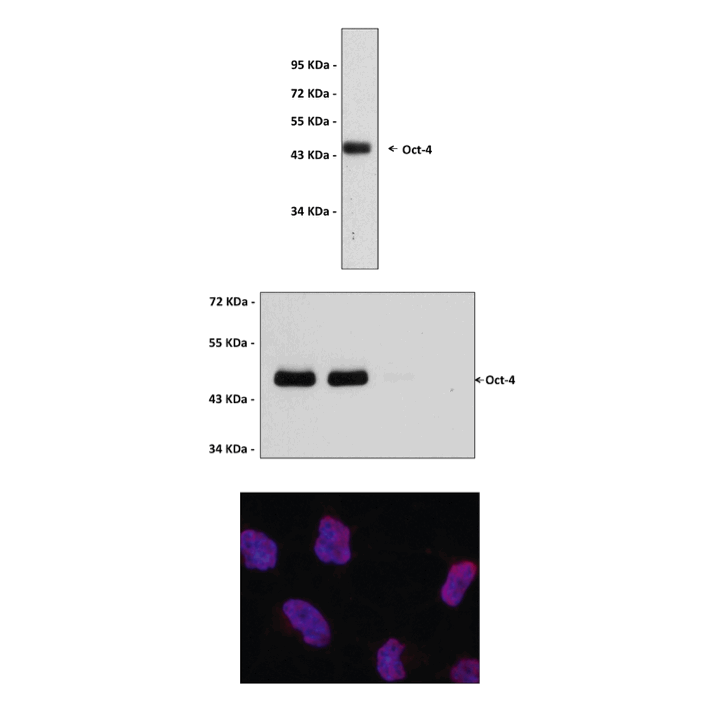Anti-Oct4: Rabbit Oct4 Antibody |
 |
BACKGROUND Oct4 (also known as Oct3) belongs to the POU (Pit-Oct-Unc) transcription factor family. The POU family of transcription factors can activate the expression of their target genes through binding an octameric sequence motif of an AGTCAAAT consensus sequence. It was shown that Oct4 is almost exclusively expressed in ES cells. During embryonic development, Oct4 is expressed initially in all blastomeres. Subsequently, its expression becomes restricted to the ICM and downregulated in the TE and the primitive endoderm. At maturity, Oct4 expression becomes confined exclusively to the developing germ cells. Targeted disruption of Oct4 in mice has produced embryos devoid of a pluripotent ICM, suggesting that Oct4 is required for maintaining pluripotency. Furthermore, quantitative analysis of Oct4 expression revealed that a high level of Oct4 expression drives ES cells towards the extra-embryonic mesoderm or endoderm lineages, while those with a low level of Oct4 become trophectodermal cells; ES cells with a normal level of Oct4 remain pluripotent. Thus, it has been proposed that Oct4 is a key regulator of stem cell pluripotency and differentiation.1
The hallmark feature of the POU family of transcription factors is the POU domain, which consists of two structurally independent subdomains: a 75 amino acid amino-terminal POU specific (POUs) region and a 60 amino-acid carboxyl-terminal homeodomain (POUh). Both domains make specific contact with DNA through a helix-turn-helix structure and are connected by a variable linker of 15 to 56 amino-acids. The N-terminal domain (N domain) is rich in proline and acidic residues, while the C-terminal domain (C domain) is rich in proline, serine and threonine residues. The N domain has traditionally been accepted for its role in transactivation. The C domain also plays a role in transactivation. It was demonstrated that the activity of Oct4 C domain is cell type specific and is regulated through phosphorylation, whereas the N domain is not. Expression of Oct4 is regulated at the transcription level by cis-acting elements located upstream of the Oct4 gene and methylation of chromatin structure.2
Oct4 is different from many known transcription regulators that appear to function in a binary on-off manner. In some cases, Oct4 can act as a repressor of target genes whereas in other cases, it acts as an activator. Oct4 controls the pluripotency of stem cells in a quantitative fashion. It was shown that high level of Oct4 expression drives ES cells to endoderm and mesoderm lineages, while stem cells with low level of Oct4 differentiate into TE. Only a "normal level" of Oct4 can retain stem cells in a pluripotent state. In addition, Oct4 may function through other transcription factors to activate or repress target genes. It was shown that Oct4 could repress the expression of FoxA1 and FoxA2 through an interaction with the DNA binding domain of their activator FoxD3. Since Oct4 does not bind to the promoters of FoxA1 and FoxA2, it behaves as a corepressor of these promoters. The demonstration that four transcription factors, Oct4/Sox2/Myc/Klf4, can reprogram fibroblasts into ES-like cells or induced pluripotent stem cells (iPS cells) has generated tremendous interests not only in the field of stem cell biology, but also those related fields such as developmental biology and regenerative medicine.3 Finally, many studies suggest a link between Oct4 and tumorigenesis.4 Like ES cells, tumor cells exhibit a unique pattern of gene expression, and thus, may be under the control of one or more master regulators like Oct4. Therefore, an understanding of Oct4 function in stem cell biology could also lead to novel treatments for certain malignancies.
REFERENCES
1. Pesce, M. & Scholer, H.: Mol. Rep. Dev. 55:452-7, 2000
2. Pesce, M. et al: BioEssays 20:722-32, 1998
3. Takahashi, K. & Yamanaka, S.: Cell 126:663-76, 2006
4. Tai, M-H. et al: Carcinogen. 26:495-502, 2006
2. Pesce, M. et al: BioEssays 20:722-32, 1998
3. Takahashi, K. & Yamanaka, S.: Cell 126:663-76, 2006
4. Tai, M-H. et al: Carcinogen. 26:495-502, 2006
Products are for research use only. They are not intended for human, animal, or diagnostic applications.
Параметры
| Cat.No.: | CG1367 |
| Antigen: | Synthetic peptide corresponding to amino acids 19-34 of human POU5F1 conjugated to KLH. The corresponding sequence in rat is 81% homologous. |
| Isotype: | Rabbit IgG |
Species & predicted species cross- reactivity ( ): | Human |
Applications & Suggested starting dilutions:* | WB 1-2 ug/mL IP 5-10 ug IHC n/d ICC n/d FACS n/d IF 2-5 ug/mL |
Predicted Molecular Weight of protein: | 43 kDa |
| Specificity/Sensitivity: | Detects endogenous Oct-4 proteins without cross-reactivity with other family members. |
| Storage: | Store at -20°C, 4°C for frequent use. Avoid repeated freeze-thaw cycles. |
*Optimal working dilutions must be determined by end user.
Документы
Информация представлена исключительно в ознакомительных целях и ни при каких условиях не является публичной офертой








